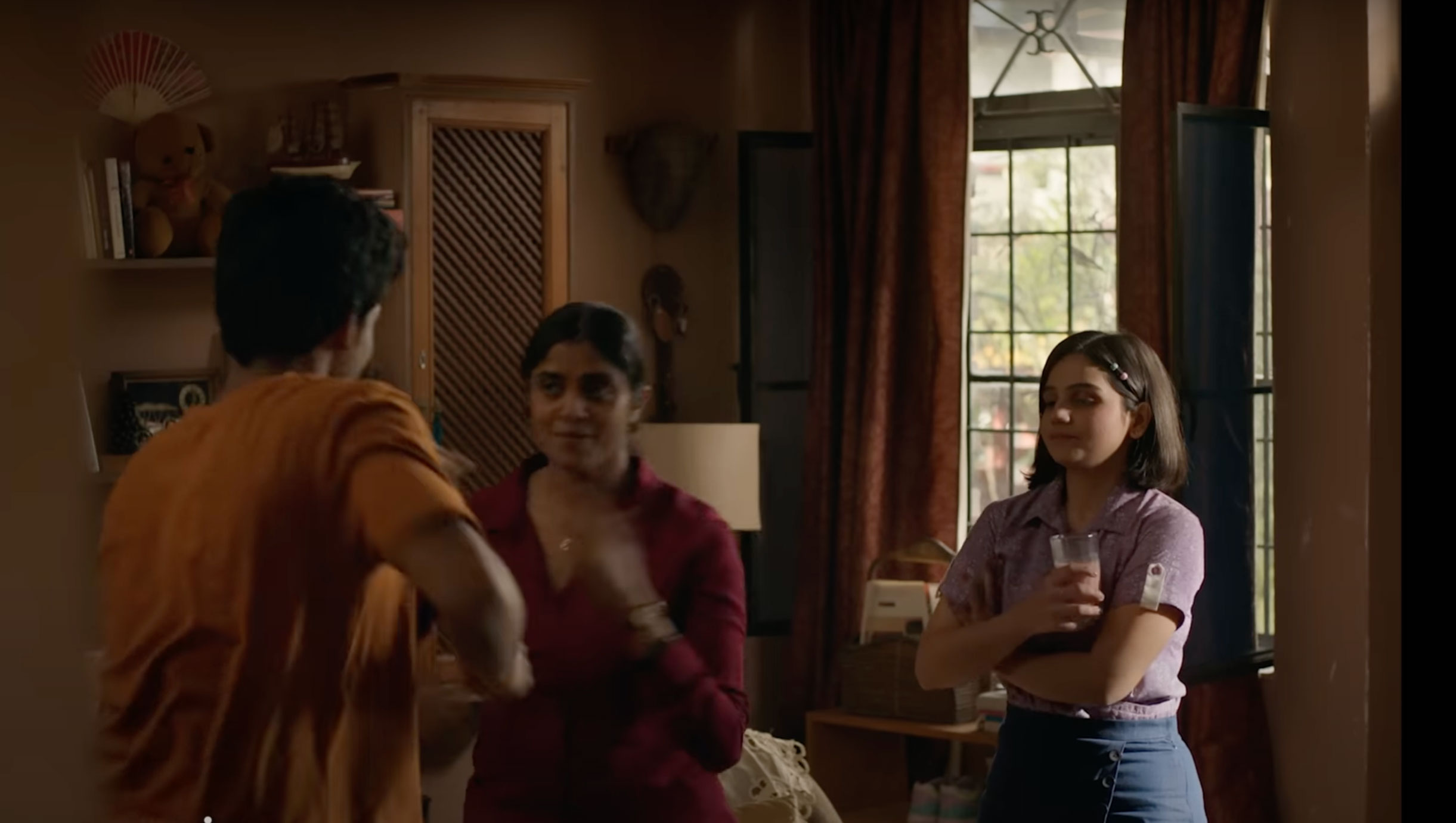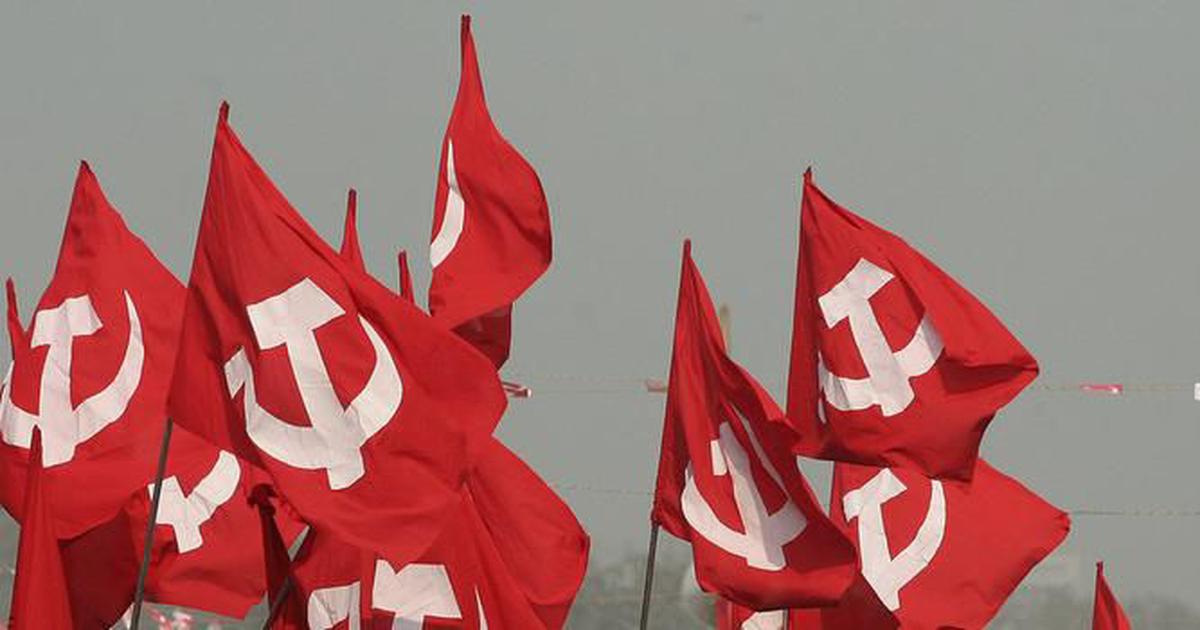It is essential to find out how this university, created in 1966 by a special Act of Parliament, became a leftist bastion. The answer lies in its unique reservation system. In this university, from the very outset, aspirants from backward districts, women and other weaker sections were given preference in enrolment. Kashmiri migrants and wards and widows of defence personnel killed in action also get preference (see box). The nature of the questions in the admission tests of the university is such that only the ability to answer multiple-choice questions related to one’s discipline is not enough to see one through. Only those students who have, apart from command over their own subject, analytical skills and reasoning power get admission here. The undergraduate courses of foreign languages are an exception in this regard. But even here, once they have a bachelor’s degree, they can join an MA or an MPhil course only if they have the aforementioned skills. Thus, for years, JNU has been home to the finest and most fertile minds from economically and socially deprived sections of society. And when they analyze the hows and whys of their socio-economic background, they get drawn to Marxism.
This fully residential university, spread over 1000 acres and nestled in the lush green Aravalli Range, never attracted the elite class. The hostels serve plain food and residents drink from jugs – instead of glasses. Estimates suggest that at least 70 per cent students of the university come from either poor or lower-middle-class families. Though the Left always dominated the students’ politics in the university, till 2006, students from economically weak but socially higher classes ruled the roost here. That was  because they outnumbered all other groups. The number of Dalit and Tribal students was capped by the 22.5 per cent reservation for them, although OBC students have been given preference in enrolments since 1995, the credit for which goes to the agitation launched by the renowned students’ leader Chandrashekhar (1964-1997) (Samajik Kranti Ke Sutradhar, Ashok Kumar Sinha, Shabda Prakashan, Patna, 2012).
because they outnumbered all other groups. The number of Dalit and Tribal students was capped by the 22.5 per cent reservation for them, although OBC students have been given preference in enrolments since 1995, the credit for which goes to the agitation launched by the renowned students’ leader Chandrashekhar (1964-1997) (Samajik Kranti Ke Sutradhar, Ashok Kumar Sinha, Shabda Prakashan, Patna, 2012).
Even then, the percentage of students from socially deprived communities, including OBCs, in the university never exceeded 28-29 per cent. In 2006, the government announced reservations for OBCs in institutions of higher learning and that drew these classes towards JNU. The fact that all students of the university get scholarships was an added attraction. As Abhay Kumar pointed out in his article “Assertion of Dalitbahujan discourse in JNU”, published in the August 2015 issue of FORWARD Press, “According to the Annual Report 2013-14, out of the 7,677 JNU students, there were 3,648 Dalitbahujan students (1,058 SCs + 632 STs + 1948 OBCs). Simply put, the percentage of non-upper-caste students today is roughly around 50 per cent. If one includes other deprived social groups, minorities and women, the upper castes and classes are a minuscule minority. As a result, during the last three years (from 2012-14), JNUSU presidents have been from the marginalized sections of society – V. Lenin Kumar (2012, SFI-JNU or DSF), an OBC from Tamil Nadu; Akbar Chawdhary (2013, AISA), a Muslim from UP; and Ashutosh Kumar (2014, AISA), a Yadav from Bihar.”
In 2012, OBC students were elected to all the four posts of JNUSU (See “Jai Joti, Jai Bheem, Jai JNU”, FORWARD Press, October 2012). The winners in the 2015 students’ union elections also reflect the same trend: President Kanhaiya Kumar, AISF (Bhumihar, Hindu upper caste); Vice-President Shehla Rashid, AISA (Muslim); General Secretary Rama Naga, AISA (Dalit); and Joint Secretary Saurabh Kumar, ABVP (OBC). It may be mentioned here that it was after a gap of 14 years that an ABVP candidate emerged victorious in the JNUSU elections. But his victory had a lot to do with his OBC roots as well. As the videos of his speech reveal, the current students’ union president Kanhaiya Kumar, who has been arrested on charges of sedition, is not only a brilliant speaker but also his speeches are a beautiful amalgam of Phule-Ambedkarism and Marxism. JNU students say that his powerful oratory was a major contributor to his victory in the elections.
After the enrolments last year, the percentage of students in JNU from SC, ST and OBC has gone up to 55. A large number of Muslims are enrolled in Arabic, Persian and other language courses in JNU. Data on them is not available. But if, along with them, the number of Ashraf Muslims and other minorities is added, it can be safely presumed that at least 70 per cent of the students in the university are non-Dwij. Note that the official figure for OBC students in JNU has gone from 288 in 2006 to 2434 in 2015, ie a tenfold increase in nine years, although apart from the 288, there would have been other OBC students who hadn’t sought a reserved seat for admission. The number of women students has also gone up substantially (see chart).
Students’ social profile
| 2005 – 2006 | 2006 – 2007 | 2013 – 2014 | 2014 – 2015 |
|
Total Students: 5,264
|
Total Students: 5,506 |
Total Students: 7,677
|
Total Students: 8,308 |
| Gender Profile
Female: 1,862 Male: 3,402 |
Gender Profile
Female: 1,878 |
Gender Profile
Male: 4,054 Female: 3,623 |
Gender Profile
Male: 4,197 Female: 4,111 |
| Social Profile
Scheduled Caste: 669 Scheduled Tribe: 370 OBC: Data not collected Physically Challenged: 104 Foreign Nationals: 241 Others: 3880 |
Social Profile
Scheduled Caste: 703 Scheduled Tribe: 425 OBC: 288 Physically Challenged: 116 Foreign Nationals: 248 Others: 3,726 |
Social Profile Scheduled Caste: 1,058Scheduled Tribe: 632OBC: 1,948Physically Challenged: 179Foreign Nationals: 297Others: 3,563 |
Social Profile Scheduled Caste: 1,201Scheduled Tribe: 643OBC: 2,434Physically Challenged: 219Foreign Nationals: 331Others: 3480 |
| 1426 candidates selected for admission. As regards the rural-urban composition of the students, the ratio was 524:902. Further, only 417 candidates had been to public schools; 1009 attended municipal and non-public schools |
288 of the total 1484 candidates (ie around 19.44%) selected for admission to various programmes were OBCs
|
As against 27% reservation for OBC candidates, 24.9% OBC candidates joined the university. In addition, the number of candidates from reserved categories who were selected on merit and joined the university as unreserved candidates is as under: Scheduled Caste: 37, Scheduled Tribes: 35, Physically Handicapped: 7, OBC: 177 | As against reservation of 27% for OBC candidates, 26.33% OBC candidates joined the university. In addition, the number of candidates from reserved categories who were selected on merit and joined the university as unreserved candidates is as under:
Scheduled Caste: 44 Scheduled Tribes: 26 Physically Handicapped: 07 OBC: 186
|
New slogans, new graffiti, new discourses
This change in the social texture of the students not only changed the composition of the students’ union but also the dominant discourse on the campus. Though leading students’ organizations continued to hold the flag of Marxism aloft, their slogans started changing. The graffiti started changing. Instead of Marx, Lenin and Mao, the slogans increasingly started quoting Birsa, Phule and Ambedkar. Portraits of Bahujan heroes who took on Manuvad and casteism started adorning the walls – so much so that it became impossible for any students’ organization to survive on the JNU campus without sporting these symbols. And the change was not limited to slogans and graffiti; the topics of research also underwent a sea change. The students from the deprived sections brought with them life experiences and thinking processes that were, hitherto, alien to the Indian academic world. They gave a new momentum, a new energy to research in the humanities. The “Left” had taken a new turn – a turn that took it away from the discourses that interested the upper classes. The radical Left has always been present here. Discussions on Naxalism, Maoism and freedom to Kashmir have been fairly common. The number of big and small functions and meetings on these and related issues to date must easily be in the thousands.
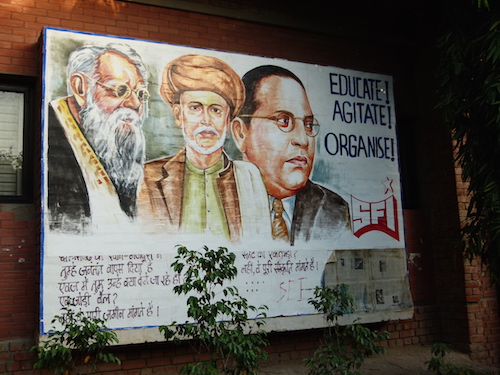 The Mahishasur and food-freedom movements were the manifestations of the new discourses that were replacing the old ones here. They drew nationwide attention. The traditional Left either looked the other way or made it clear that it would stand by the freedom of expression and would not oppose these voices coming from the deprived sections. This was, in a sense, the coming-together of Left and Bahujan ideologies or, at the very least, the two camps agreeing on a common minimum programme.
The Mahishasur and food-freedom movements were the manifestations of the new discourses that were replacing the old ones here. They drew nationwide attention. The traditional Left either looked the other way or made it clear that it would stand by the freedom of expression and would not oppose these voices coming from the deprived sections. This was, in a sense, the coming-together of Left and Bahujan ideologies or, at the very least, the two camps agreeing on a common minimum programme.
Sangh on the backfoot
The RSS calls itself a cultural organization and is perpetually busy in protecting and preserving the brahmanical culture. The young Bahujan intellectuals were dealing blow after fatal blow to the brahmanical culture, and this won them the approval of the Left in JNU. The amalgamation of the thoughts of Phule, Ambedkar, Periyar and Narayan Guru on the one hand and Marx, Lenin and Mao on the other threw up compelling arguments and incontrovertible facts. This, in turn, started influencing the students. A flummoxed Sangh did not know how to counter this assault. The deprived sections posed a stiff challenge – the stiffest in independent India – to the brahmanical culture, which the Sangh was trying to protect in the name of the Hindu religion, and behind it was the intellectual prowess of the JNU Bahujan research scholars. They were now capable of presenting their views in keeping with the highest academic standards.
The Sangh, so far, has been using issues like cow slaughter to further its ends. It understands quite well the meaning of the proverb “Give a dog a bad name and hang him”. Like in Europe in the Middle Ages, and in some Middle East countries today, the weapon of blasphemy has been used to silence the opposition. Whosoever did or said anything that was unpalatable to the Sangh was promptly accused of blasphemy and declared anti-religion and an atheist. This won the Sangh the support of the masses. But this time, things did not go the Sangh’s way. From within the Hindu religion – which was the mainstay of Sangh’s politics – rose dissenting voices that proclaimed that they would not worship the goddess who massacred Tribals, Backwards and Dalits. The proponents of the Mahishashur movement in JNU were saying, “You may have presented our heroes as villains in your scriptures but we will dig them out from non-brahmanical texts and re-anoint them. The Asur tribe of Jharkhand – which, along with the Santhals, Bhils, Gonds, etc, has been declared a primitive tribe by the Government of India – has been worshipping Mahishasur as its ancestor for thousands of years. There are innumerable totems associated with the Asur tradition in other Dalitbahujan castes. Celebrating Mahishasur’s murder was improper. This country has been worshipping women for thousands of years – primarily due to the influence of the Tribal and Bahujan traditions – but Brahminism had distorted the tradition of worshipping women and portrayed them as violent and anti-women. The celebrations of Durga Puja in its present form began just 260 years ago, when after the Battle of Plassey in 1757, Nabakrishna Deb of Calcutta organized the first Durga Puja in honour of Lord Clive. Thus, this festival is not only very new but it is also anti-Muslim and pro-imperialism by implication.”
These young intellectuals thus gave an entirely new meaning to Durga Puja, a festival that was used by the Sangh to brand the original inhabitants of India as demons and villains. Similarly, beef and pork, which were used to engineer many a communal riot, were made a food-freedom issue by the Hindu and Muslim students of JNU. Their arguments regarding pork and beef festivals started reaching the wider society through the media. They told the middle-class Hindus and Muslims, who were unaware of the ground reality: “Beef and pork had always been the staple food of the Hindu Dalits and were the biggest source of protein for the poorer sections of society. Beef and pork are widely consumed in most parts of the northeast. Since students from all over the country studied in JNU, food-related taboos put them under psychological pressure to hide their food preferences.”
The Sangh, this time around, chose sedition instead of blasphemy as the ammunition for its assault. It replaced God with the nation and declared sinful any attempt to question what the nation does or to argue about it. And punishing the sinner, of course, was the sacred duty of every citizen. The BJP, which had demanded that temples of Saraswati be established in all educational institutions, is now ruling the country. On 18 February, the Government of India, referring to “seditious activities” on the JNU campus, issued an order for the national flag to be hoisted on a 207-foot high pole in every university, beginning with JNU. Needless to say, if this goes ahead unopposed, it would be difficult to oppose the installation of an idol of Bharat Mata near the flag. In the post-Independence brahmanical myths, the tiger-riding Durga and the tiger-riding Bharat Mata are all but the same. These symbols have deep significance as far as cultural domination is concerned. We should not forget that cultural domination is the foundation of economic, social and political domination. Hoisting the national flag is a matter of pride for all Indians but the circumstances in which the government has issued this order and its motive deserve condemnation.
Bahujan movements at JNU
If we closely study the recent string of incidents in JNU while keeping their background in mind, we will realize that the Bahujan-Left unity had set alarm bells ringing in the RSS camp. To grasp this better, we will have to revisit the first Mahishasur Martyrdom Day, organized by the All India Backward Students’ Forum (AIBSF) in JNU in October 2011 and the Food Freedom movement initiated by the New Materialists in September 2012. As evident from their names, the All India Backward Students’ Forum, which observed the Mahishasur Martyrdom Day, is officially an organization of OBC students and the New Materialists, which made food freedom an issue, is also related to the now-forgotten, philosophical Lokayat tradition of the Bahujans. The New Materialists was led by OBC and Dalit students who were advocates of scientific materialism.
Some had begun referring to the Food Freedom movement as the Beef-Pork Festival. The Delhi High Court banned the holding of the event. The Rashtriya Gorakshini Sena took the organizers to court and activists of the VHP and other outfits of the Sangh Parivar called on the then vice-chancellor and demanded tough action against them. After this meeting, the VC suspended the leader of the New Materialists, an OBC, and issued show-cause notices to three others (See “JNU bows before Hindutvavadis”, FORWARD Press, October 2012)
The organizers had planned to serve beef and pork, along with dishes from different states, to interested students in an open ground on the campus. A similar event was earlier held in the Osmania University in Hyderabad and both the groups of student organizers had the ideological backing of Prof Kancha Iliah, who is greatly respected by Bahujan students.
The reactions of RSS and its auxiliary organizations to Mahishasur and Food Freedom movements, as published in different newspapers and magazines in 2011-12, indicate that initially, these organizations could not comprehend what exactly was happening.
The movement for food freedom lost steam after the Delhi High Court order but the Mahishasur Day celebrations became an annual affair after 2011. It also spread to other parts of the country. In 2013, it was celebrated at around 100 places including cities, towns and university campuses. By 2015, this number had crossed the 350 mark. In May 2014, the BJP, the political wing of the RSS, formed its government at the Centre. The Sangh identified FORWARD Press as being responsible for giving momentum to Mahishasur Day celebrations and decided to target the magazine. In October 2014, some people associated with Hindutva organizations lodged a complaint against the magazine with the police. Reports published in various newspapers quoted police sources to say that the raid on the magazine’s office was conducted at the directive of the union home ministry. In this period, while The Hindu, Indian Express, Deccan Herald, Jansatta, etc presented all the related facts and gave due prominence to the explanation by FORWARD Press that it had nothing to do with the holding of the event in JNU, the RSS’ Panchjanya and Organizer and rightist newspapers such as The Pioneer and Dainik Jagran continued spreading disinformation about FORWARD Press.
Panchjanya 2015
The real assault on Bahujan discourses followed. In its issue dated 8 November 2015, Panchjanya, the Hindi organ of the Sangh, carried a sensational and provocative cover story titled “JNU: Darar ka gadh” (JNU: Den of Divisiveness). That is not all. The weekly took pains to inform media organizations about the cover story and requested them to take notice. In the first week of November 2015, this cover story of Panchjanya grabbed the headlines on TV channels. The Panchjanya story revealed, for the first time, that the real target of the Sangh was the growing Left-Bahujan proximity in JNU.
Later, in this article, we will examine the contents of the Panchjanya cover story and compare them with the intelligence report that was sent to the Home Ministry after the so-called seditious slogans were raised on the campus. This will make it clear that the Sangh and the police were speaking in the same language and that the “sedition” charge was a part of the Sangh’s conspiracy. The Sangh wanted to use it as an excuse to crush Bahujan discourses.
Panchjanya and government spies
As we had hinted at the beginning of this article, the recent events in JNU were not triggered by the so-called anti-national slogans alone. Their real objective was to target Muslims and give a bad name to those Hindu Bahujans who are resisting the brahmanical culture.
First, let us see what Panchjanya said in its cover story JNU: Darar Ka Gadh in the issue dated 8 November 2015:
“JNU is the only institution where talking of nationalism is a sin. It is called a bastion of the leftists. Distorting Indian culture and presenting it in conjunction with wrong facts is fairly common here. For instance, when the entire country worships Ma Durga, neo-leftist students and professors celebrate Mahishasur Day there. They demand that the army should be withdrawn from the terrorism-infested Kashmir … Those who celebrate Mahishasur Day say that they are backward and deprived and representatives of forest dwellers and claim that Mahishasur was the hero-god of the backwards, the deprived and the forest-dwellers.”
Referring to the changing nature of JNU, Panchjanya says, “Till some time ago, the leftists used a different set of policies and tools to break the nation and society. With time, their strategy has changed. They have changed their faces; they have changed the arena of their ideological battle. Now, they do not parrot the formulations of Lenin. Now they talk of secularism, human rights and rights of minorities, women and the deprived sections of society to implement their agenda. The lush crops grown on this poison can be seen everywhere in the university. The walls on JNU campus are full of slogans, pamphlets and posters. Most of these slogans and posters are aimed at fracturing Indian culture, civilization and society and the country itself.” Panchjanya blames the discourses initiated by the FORWARD Press for the changes in the slogans, posters, etc and condemns the magazine under the subhead “Forward Press ka vishwavidhyalaya connection”. It says, “They are using a new word, Bahujan, to describe deprived sections and forest dwellers together…a couple of years back, at a programme in JNU, Kancha Iliah, who was an assistant professor in Osmania University and Professors A.K. Ramakrishnan and S.N. Malakar of the University, in their speeches, spewed venom against the upper-caste Hindus.” Besides Panchjanya and Organizer, the organs of the RSS, newspapers like The Pioneer and Dainik Jagran and rightist websites like Niti Central, Central Right India and India Facts are also quite upset with the concept of “Bahujan”. Among other things, this concept is being opposed because SC, ST and OBC are Constitutional terms for these classes. They say that the floating of the concept of Bahujan – which includes all people of these classes as well as those Dwijs who are opposed to the caste system – is a foreign conspiracy against the Hindus. The leftist stream of JNU is turning towards this concept of “Bahujan”.
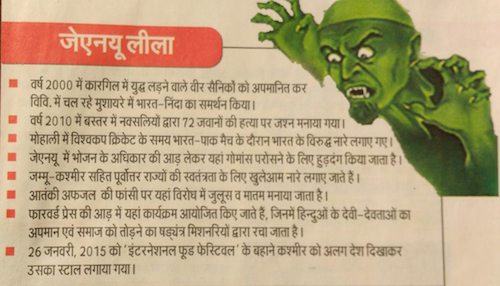 It was for this reason that Panchjanya, in its cover story, described JNU as an institution which is “breaking the nation”, where “innocent Hindu youth are lured after being fed wrong facts about the Varna system, which is an integral part of Hindu society” and where “venom is spewed against the Savarnas” and impliedly urged the Savarnas and its government to launch a campaign against the institution. It is not without reason that a portion of this story has been carried in the name of Ravindra Kumar Baseda, a former student of JNU. Baseda was one of the people who had lodged the complaint with the police against the observance of Mahishasur Day in JNU in 2014. In the complaint, it was stated that the observance of this day would “exacerbate tensions between the Brahmins and the OBCs”.
It was for this reason that Panchjanya, in its cover story, described JNU as an institution which is “breaking the nation”, where “innocent Hindu youth are lured after being fed wrong facts about the Varna system, which is an integral part of Hindu society” and where “venom is spewed against the Savarnas” and impliedly urged the Savarnas and its government to launch a campaign against the institution. It is not without reason that a portion of this story has been carried in the name of Ravindra Kumar Baseda, a former student of JNU. Baseda was one of the people who had lodged the complaint with the police against the observance of Mahishasur Day in JNU in 2014. In the complaint, it was stated that the observance of this day would “exacerbate tensions between the Brahmins and the OBCs”.
A box accompanying the story, which had an aggressive layout, titled “JNU Leela”, listed the “nefarious activities” on JNU campus.
JNU Leela
- The valiant soldiers who fought in the Kargil battle were humiliated in a mushaira in the university and India-bashing was supported.
- The killing of 72 jawans by the Naxals in Bastar in 2010 was celebrated.
- In the name of food freedom, a row was kicked up over serving beef.
- Slogans demanding freedom for J&K and northeastern states were openly raised
- The hanging of Afzal Guru was mourned and a protest march taken out.
- With the support of Forward Press, programmes were organized to insult Hindu gods and to execute the conspiracy of the missionaries to break society.
As we shall see ahead, the charges levelled by Panchjanya in November 2015, surprisingly, became part of an intelligence report filed in February 2016. The Panchjanya article and the report of the intelligence department have uncanny similarities. Their tone is the same, basic content is the same, charges are the same and both smack of a conspiracy to associate students’ organizations of Bahujan ideology with extremist leftist organizations. The only difference is that of language. While the language of Panchjanya has a literary touch, that of the intelligence report is dry government-speak.
Delhi Police situation report
On 9 February 2016, after the so-called seditious sloganeering in JNU, the Delhi Police, on the basis of the report of its intelligence wing, submitted a report to the Government of India. This report was leaked to the media by “sources in the Home Ministry” on the basis of which, Firstpost, The Hindu, The Indian Express, The Times of India, The Telegraph and other newspapers and TV channels ran stories on the “celebration of Mahishasur Day in JNU during Navratri” and on the “demand to serve beef in JNU mess”. Barring BJP-supporter Zee News and few other channels and newspapers, most of the media outlets took a dig at the government for treating these events as “seditious”. But even they were unaware of the facts and could not grasp the issue in its entirety.
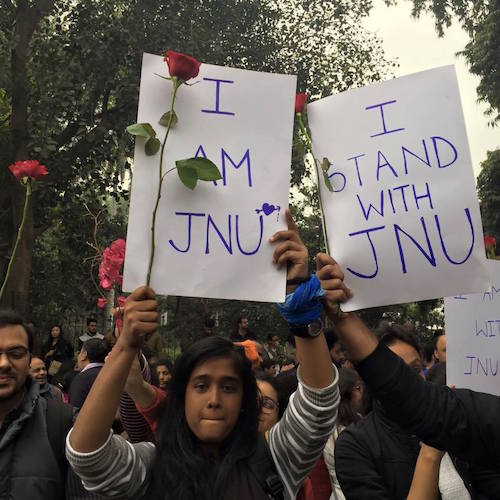 Let us see what this four-page report of the intelligence wing of the Delhi police titled “Situation report regarding the incident at Jawahar Lal Nehru University on 09.02.16” says. The first two pages of the report are devoted to the incident of 9 February. The two remaining pages are about the “earlier incidents” in JNU, including “celebrations of Mahishasur Day during Navratri in 2014” and the “demand that beef be served in the hostel mess”. The question that arises is: Why did the police report talk in detail about the older incidents, which had nothing whatsoever to do with the so-called seditious sloganeering? And why was this report made available to media in haste? And how is it that two days before the release of the report to the media, on 15 February, newspapers carried a statement of BJP MP Yogi Adityanath in which he branded “observance of Mahishasur Day” and “holding beef party” as acts of sedition and demanded that JNU be shut down.
Let us see what this four-page report of the intelligence wing of the Delhi police titled “Situation report regarding the incident at Jawahar Lal Nehru University on 09.02.16” says. The first two pages of the report are devoted to the incident of 9 February. The two remaining pages are about the “earlier incidents” in JNU, including “celebrations of Mahishasur Day during Navratri in 2014” and the “demand that beef be served in the hostel mess”. The question that arises is: Why did the police report talk in detail about the older incidents, which had nothing whatsoever to do with the so-called seditious sloganeering? And why was this report made available to media in haste? And how is it that two days before the release of the report to the media, on 15 February, newspapers carried a statement of BJP MP Yogi Adityanath in which he branded “observance of Mahishasur Day” and “holding beef party” as acts of sedition and demanded that JNU be shut down.
See the first two pages of the report, which talks about the “sedition”. The report, which was sent to the Union Home Ministry, says: “It is important to mention here that Y&S section of Special Branch always keeps an eye on the activities of students, student organizations, youths and people who have a stake at JNU.”
The report says, “[a]round 5 pm, DSU students led by their president Umar Khalid, convenor, DSU began to gather near Sabarmati Dhaba. Around 80/100 DSU and Left students were present at the venue.” It also claims that “The Left-supported student groups were shouting ‘Bharat ki Barbadi tak jang rahegi jang rahegi’, ‘Kashmir ki Ajadi tak Jang Rahegi, Jung rahegi’, ‘India Go Back’ ‘Pakistan Zindabad’, ‘Kitne Afzal maroge, ghar ghar se Afzal niklega’.
“In the meantime 30/40 activists from ABVP reached there under the leadership of Sh. Sourav Kumar Sharma, Joint Secretary, JNUSU. They were shouting slogans against DSU and shouting Bharat Mata Ki Jai.” Note that while the references to leaders of other organizations don’t have the respectful “Shri”, it has been used with the name of Saurabh Kumar Sharma, president of the RSS’ student wing ABVP.”
The report adds, “At 7:30pm the activists of DSU & ABVP started their march from Sabarmati Dhaba to Ganga Dhaba. They raised slogans against each other. At 8:30 PM the activists of DSU & ABVP dispersed from there peacefully.” Demonstrations and sloganeering demanding the right to self-determination for the people of Kashmir are common on JNU campus and after such events, the students invariably disperse peacefully. Then, why did the sleuths take this particular event so seriously?
The report says, “At present, ABVP [is] alleging that the activists of DSU and other left supporting student organizations are indulged in anti-national activities. They want action against such students who are into such anti national activities.”
This is broadly the content of the first two pages of the report.
Sangh’s fingerprints on police report
The next two pages have been appended to the report without any apparent reason. It says, “On 06.10.2015, ACP, Y&S/SB visited JNU and had a meeting with the then VC of JNU . During this meeting discussions were held on various subjects including CCTV surveillance in JNU campus to avoid any untoward incident. It was discussed that often some student groups raise slogans and participate in protests inside JNU campus. Many a time such slogans/protests have anti-national colour. It is reflected through objectionable posters which are prepared mostly through computers and affixed at hostel/JNU campus. Sometimes such posters are found to be hurting patriotic/religious feelings of the society. It was also discussed that the objectionable/anti-national activities of members of Democratic Students’ Union (DSU) have to be curbed by JNU authorities with the help of police.”
What is significant is that an ACP of the Special Branch met the JNU vice-chancellor on 6 October 2015. The Mahishasur Martyrdom Day is observed on Sharad Purnima, which fell on 26 October last year. It is clear that the proposal to install CCTV cameras on the university premises was made in view of this event. Note how “patriotic/religious feelings” and “objectionable/anti-national” have been used as synonyms. Even if we do not dwell on whether the sentiments of only the protectors of brahmanical culture are “hurt” or whether anything which they dislike becomes “objectionable”, the question that remains is whether observance of Mahishasur Day by the deprived sections is “sedition”. It is noteworthy that later, on 24, 25 and 26 February, in the Lok Sabha and Rajya Sabha respectively, the government attacked the Mahishasur movement and linked it to seditious activities on the basis of the fabricated charges in this report.
The report shrewdly attributes the event to DSU, even when it is well known that All India Backward Students’ Forum, the Phule-Ambedkarite organization of Bahujan students, was the organizer of this event. Furthermore, it says: “There are so many Left-supported student unions active in JNU. Most of them are non-reactive and mild in nature. They often raise slogans/protest on different national as well as local issues but their gathering remains very low. But two hidden students groups i.e. 1) DSU and 2) DSF have been found volatile and reactive. However, they are less than 10 in number. Sometimes they prepare nude and objectionable posters of deities on their computer and affix it on wall to hurt the religious feelings of the society. Their activities in the past are:
1) They mourned the death of Afzal Guru.
2) They celebrated killing of CRPF Jawans in Dantewara, Chattisgardh in 2010.
3) They worshipped ‘Mahisasur’ [sic] in place of Goddess Durga during September 14 ‘Navrata’ festival last year.
4) They invited Kashmiri separatist leader Gilani for meeting. But JNU authority imposed ban on their such moves.
5) They asked for beef in hostel mess.”
Isn’t this list of charges in the police report a rough translation of the ‘JNU Leela” published in Panchjanya. The report also says that these groups put up pictures of gods and goddesses in the nude on walls. No such thing has ever happened in JNU. The posters put up by the All India Backward Students’ Forum in 2011 were a reproduction of an article written by Prem Kumar Mani titled “Who are Bahujans really worshipping?”, published in FORWARD Press. It only mentioned that Mahishasur came from the Bahujan community. It did not make any objectionable comment about any god or goddess. The police report, as part of a well-planned conspiracy, says, “They worshipped ‘Mahisasur’ in place of Goddess Durga during September 14 ‘Navrata’ festival last year.” The fact is that Mahishasur Day is celebrated in JNU and all over the country on Sharad Purnima, five days after Dussehra, whereas Navratri is celebrated before Dussehra. In 2014, Mahishasur Day was celebrated on 9 October and Navratri from 25 September to 3 October. The Mahishasur Day celebrations in JNU in 2014 were much talked about due to the registration of a case against FORWARD Press. Almost all newspapers and channels had carried news about it. The police record also mentions the date of celebrations, 9 October. Then, would it be wrong to presume that the lie of “Mahishasur Day celebrations during Navratri” was peddled only to incite people?
Similarly, the claim that a students’ organization had demanded that beef should be served in hostel mess is a white lie. The New Materialists had planned to hold Beef-Pork Festival for a couple of hours on an open ground and not in the mess. Here too, very shrewdly, ‘pork’ has been dropped from “beef-pork” so that the event can be given a religious colour. Instead of upholding the Constitutional secularism, the police report seeks to fan Hindu communalism by linking these two events with DSU and DSF. DSU is associated with the CPI (Maoist), which has been banned by the Government of India. The police and government are trying to link Bahujan youths with organizations that are on the radar of security agencies even when they are ideologically disparate, so that they lose popular support and can be subjected to police atrocities.
Anyway, these are not the final truths vis-à-vis a nexus of government, police and a section of the media trying to prove that JNU is a centre of “sedition”. But one thing is certain. The reverberations of the tumult in the dominant classes due to the entry of Bahujan youths in the portals of institutions of higher learning will continue to be felt in the years to come. Truth, equality and justice will ultimately win — no matter how long it takes.
Special reservation system
- Points are awarded to students writing the entrance exam in JNU if they hail from scheduled backward districts. For this purpose, a list of districts identified by the JNU on the basis of Census 2011 has been given in the prospectus. The districts are divided into two categories. The students who are residents of the districts in category 1and 2 are given 5 and 3 points respectively. Candidates who have passed their qualifying examination through a distance education programme are also awarded 5 or 3 points, as the case may be.
- Kashmiri migrants are awarded 5 points if they present any documentary evidence or a certificate issued by the competent authority to prove their status.
- Candidates from the following defence categories are eligible for 5 special points:
- Widows/wards of defence personnel killed in action;
- Wards of serving personnel and ex-servicemen disabled in action;
- Widows/wards of defence personnel who died in peacetime with death attributable to military service; and
- Wards of defence personnel disabled in peacetime with disability attributable to military service.
- All female candidates are awarded 5 special points. (No candidate is given more than 10 special points.)
Note: These points are given in addition to the reservations granted to SC, ST, OBC and physically challenged students by the government. For example, if an OBC student comes from a scheduled district, besides benefiting from the 27 per cent reservation, he will also get five additional points, which will not be given to an OBC student hailing from a city.
(Mahishasur: Ek Jan Nayak (Hindi) chronicles and explains the Mahishasur movement. Visit http://www.amazon.in/dp/819325841X and get yourself a copy. The English edition will be available soon)



